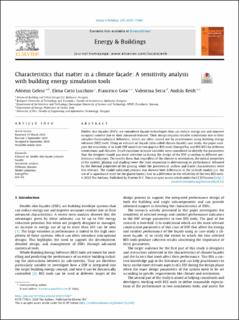| dc.contributor.author | Gelesz, Adrienn | |
| dc.contributor.author | Catto Lucchino, Elena | |
| dc.contributor.author | Goia, Francesco | |
| dc.contributor.author | Serra, Valentina | |
| dc.contributor.author | Reith, András | |
| dc.date.accessioned | 2020-11-17T09:50:11Z | |
| dc.date.available | 2020-11-17T09:50:11Z | |
| dc.date.created | 2020-11-10T18:35:15Z | |
| dc.date.issued | 2020 | |
| dc.identifier.citation | Energy and Buildings. 2020, 229 . | en_US |
| dc.identifier.issn | 0378-7788 | |
| dc.identifier.uri | https://hdl.handle.net/11250/2688186 | |
| dc.description.abstract | Double skin façades (DSFs) are considered façade technologies that can reduce energy use and improve occupant comfort due to their advanced features. Their design requires reliable simulations due to their complex thermophysical behaviour, which are often carried out by practitioners using building energy software (BES) tools. Using an exhaust-air façade (also called climate façade) case study, the paper analyses the sensitivity of in-built DSF models in two popular BES tools (EnergyPlus and IDA ICE) for different orientations and climates. Small variations in input variables were considered to identify the parameters that the designer should pay most attention to during the design of the DSF according to different performance indicators. The results show that, regardless of the climate or orientation, the optical properties of the system (glazing and shading) were the most important in determining its performance, followed by the thermal properties of the glazing, while the geometrical, airflow and frame characteristics were less relevant. The model validation process also showed how differences in the in-built models (i.e. the use of a capacitance node for the glazed layers) lead to a difference in the reliability of the two BES tools. | en_US |
| dc.language.iso | eng | en_US |
| dc.publisher | Elsevier | en_US |
| dc.rights | Navngivelse 4.0 Internasjonal | * |
| dc.rights.uri | http://creativecommons.org/licenses/by/4.0/deed.no | * |
| dc.title | Characteristics that matter in a climate façade: A sensitivity analysis with building energy simulation tools | en_US |
| dc.type | Peer reviewed | en_US |
| dc.type | Journal article | en_US |
| dc.description.version | publishedVersion | en_US |
| dc.source.pagenumber | 25 | en_US |
| dc.source.volume | 229 | en_US |
| dc.source.journal | Energy and Buildings | en_US |
| dc.source.issue | 110467 | en_US |
| dc.identifier.doi | 10.1016/j.enbuild.2020.110467 | |
| dc.identifier.cristin | 1846696 | |
| dc.relation.project | Norges forskningsråd: 257660 | en_US |
| dc.relation.project | Norges forskningsråd: 262198 | en_US |
| dc.description.localcode | This is an open access article distributed under the terms of the Creative Commons CC-BY license, which permits unrestricted use, distribution, and reproduction in any medium, provided the original work is properly cited. | en_US |
| cristin.ispublished | true | |
| cristin.fulltext | original | |
| cristin.qualitycode | 2 | |

